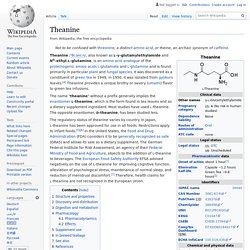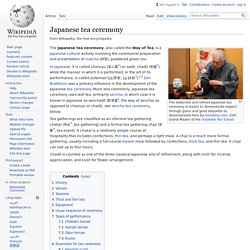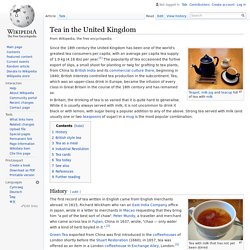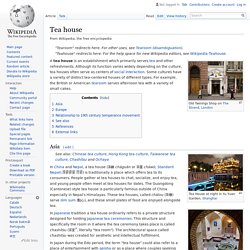

Art Tatum - Tea for Two (Audio+Sheet Music) "A Nice Cup of Tea" from "Home & Beauty" Sung by Gracie Fields Rex 9114. How to Brew A Really Good Cup of Tea: Traditional Japanese Ceremony. The Guide to Brewing Tea. The 8 Types Of Tea. Chinalife Tea House. Theanine. Theanine , also known as L-γ-glutamylethylamide and N5-ethyl-L-glutamine, is an amino acid analogue of the proteinogenic amino acids L-glutamate and L-glutamine and is found primarily in particular plant and fungal species.

It was discovered as a constituent of green tea in 1949; in 1950, it was isolated from gyokuro leaves.[4] Theanine provides a unique brothy or savory (umami) flavor to green tea infusions. The name "theanine" without a prefix generally implies the enantiomer L-theanine, which is the form found in tea leaves and as a dietary supplement ingredient. Most studies have used L-theanine.
The opposite enantiomer, D-theanine, has been studied less. The regulatory status of theanine varies by country. Structure and properties[edit] The chemical name N5-ethyl-L-glutamine[2] and other synonyms (see box) for theanine reflect its chemical structure. Relative to theanine, the opposite (D-, R-) enantiomer is largely absent from the literature,[2] except implicitly.
Tea - The Story of A Leaf. Tea Documentary - History channel seems a fairly unreliable resource but a few interesting thingies here. Tea: A Revolution Brewing - BBC World News TV Documentary - 2014. JACK BUCHANAN: Everything Stops for Tea. A nice cup of tea - Binnie Hale. Japanese tea ceremony. The elaborate and refined Japanese tea ceremony is meant to demonstrate respect through grace and good etiquette as demonstrated here by Genshitsu Sen, 15th Grand Master of the Urasenke Tea School The Japanese tea ceremony, also called the Way of Tea, is a Japanese cultural activity involving the ceremonial preparation and presentation of matcha (抹茶), powdered green tea.

In Japanese, it is called chanoyu (茶の湯?) Or sadō, chadō (茶道?) , while the manner in which it is performed, or the art of its performance, is called (o)temae ([お]手前; [お]点前?). [1] Zen Buddhism was a primary influence in the development of the Japanese tea ceremony. Tea gatherings are classified as an informal tea gathering chakai (茶会? Chadō is counted as one of the three classical Japanese arts of refinement, along with kōdō for incense appreciation, and kadō for flower arrangement. History[edit] In China, tea had already been known, according to legend, for more than a thousand years. Tea in the United Kingdom. Since the 18th century the United Kingdom has been one of the world's greatest tea consumers per capita, with an average per capita tea supply of 1.9 kg (4.18 Ibs) per year.[1] The popularity of tea occasioned the furtive export of slips, a small shoot for planting or twig for grafting to tea plants, from China to British India and its commercial culture there, beginning in 1840; British interests controlled tea production in the subcontinent.

Tea, which was an upper-class drink in Europe, became the infusion of every class in Great Britain in the course of the 18th century and has remained so. In Britain, the drinking of tea is so varied that it is quite hard to generalise. While it is usually always served with milk, it is not uncommon to drink it black or with lemon, with sugar being a popular addition to any of the above. Strong tea served with milk (and usually one or two teaspoons of sugar) in a mug is the most popular combination. Tea house. "Teahouse" redirects here.

For the help space for new Wikipedia editors, see Wikipedia:Teahouse. Asia[edit] Tea House at night in Yu Yuan Garden, Shanghai A Chaikhaneh (tea house) in Yazd In China and Nepal, a tea house (茶館 cháguăn or 茶屋 cháwū; Standard Nepali:चिया घर) is traditionally a place which offers tea to its consumers. BBC Radio 4 - In Our Time, Tea.